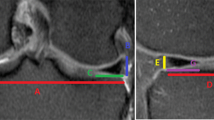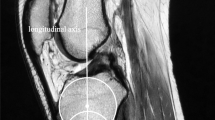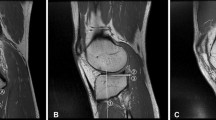Abstract
Purpose
The purpose of this study was to quantify the posterior horn meniscal slope and determine its contribution to the reduction in posterior tibial slope.
Methods
Patients aged between 16 and 60 years and had intact menisci with no evidence of previous injury or surgery were included. Patients with radiological evidence of osteoarthritis Grade II–IV, any acute or chronic meniscus injuries, fractures, and ligamentous injuries were excluded. The posterior bony slope (PTS) and the meniscus slope (MS) of the posterior horns were measured at 25, 50, and 75% from the medial and lateral borders of the tibial plateau.
Results
325 MR images (mean age 37.1 ± 10.9 years) were included. There were 194 males and 131 females, with 162 left and 163 right knees. The PTS in the medial compartment ranged from (−) 2.8° to 3.7° and from (−) 1.3° to 1.9° in the lateral compartment (p = 0.0001). The MS in the medial compartment ranged from 27.4° to 28.2°, and from 27.8° to 28.7° in the lateral compartment (p > 0.05). The differences between the medial and lateral knee compartment were statistically significant. At the 25% interval the p level was 0.037, at 50% p = 0.00001, and at 75% p = 0.0001. There were no significant between gender differences.
Conclusions
The results of this study demonstrated a significant reduction in posterior tibial bone slope by the posterior horns of both the medial and lateral meniscus, from a mean of (−) 1° to 2° to a more horizontal anterior slope. The posterior bone slope was larger in the medial compartment by 1°, resulting in a smaller slope reduction in the lateral compartment.




Similar content being viewed by others
References
Ahn JH, Bae TS, Kang KS et al (2011) Longitudinal tear of the medial meniscus posterior horn in the anterior cruciate ligament-deficient knee significantly influences anterior stability. Am J Sports Med 39:2187–2193. https://doi.org/10.1177/0363546511416597
Alici T, Esenyl CZ, Esenyl M (2011) Relationship between meniscal tears and tibial slope on the tibial plateau. Eurasian J Med 43:146–151. https://doi.org/10.5152/eajm.2011.35
Allen CR, Wong EK, Sakane M et al (2000) Importance of the medial meniscus in the anterior cruciate ligament-deficient knee. J Orthop Res 18:109–115. https://doi.org/10.1002/jor.1100180116
Bendjaballah MZ, Shirazi-Adl A, Zukor DJ (1998) Biomechanical response of the passive human knee joint under anterior-posterior forces. Clin Biomech (Bristol, Avon) 13:625–633. https://doi.org/10.1016/s0268-0033(98)00035-7
Beynnon BD, Slauterbeck JR, Schutt RC Jr, Mansouri H, Dabezies E (2008) The geometry of the tibial plateau and its influence on the biomechanics of the tibiofemoral joint. J Bone Joint Am 90:2724–2734. https://doi.org/10.2106/JBJS.G.01358
Chen L, Linde-Rosen M, Hwang SC et al (2015) The effect of medial meniscal horn injury on knee stability. Knee Surg Sports Traumatol Arthrosc 23:126–131. https://doi.org/10.1007/s00167-014-3241-9
Dejour H, Bonnin M (1994) Tibial translation after anterior cruciate ligament rupture. Two radiological tests compared. J Bone Joint Surg Br 76:745–749
Elmansori A, Lording T, Dumas R et al (2017) Proximal tibial bone and meniscal slopes are higher in ACL injured subjects than controls: a comparative MRI study. Knee Surg Sports Traumatol Arthrosc 25:1598–1605. https://doi.org/10.1007/s00167-017-4447-4
Forkel P, von Deimling C, Lacheta L et al (2018) Repair of the lateral posterior meniscal root improves stability in an ACL-deficient knee. Knee Surg Sports Traumatol Arthrosc 26:2302–2309. https://doi.org/10.1007/s00167-018-4949-8
Han H, Oh S, Chang CB, Kang SB (2016) Anthropometric difference of the knee on MRI according to gender and age groups. Surg Radiol Anat 38:203–211. https://doi.org/10.1007/s00276-015-1536-2
Hashemi J, Chandrasekar N, Gill B et al (2008) The geometry of the tibial plateau and its influence on the biomechanics of the tibiofemoral joint. J Bone Joint Am 90:2724–2734. https://doi.org/10.2106/JBJS.G.01358
Hashemi J, Chandrasekar N, Mansouri H et al (2010) Shallow medial tibial plateau and steep medial and lateral tibial slopes: new risk factors for anterior cruciate ligament injuries. Am J Sports Med 38:54–62. https://doi.org/10.1177/0363546509349055
Hohmann E, Bryant A, Reaburn P et al (2011) Is there a correlation between posterior tibial slope and non-contact anterior cruciate ligament injuries? Knee Surg Sports Traumatol Arthrosc 19:S109-114. https://doi.org/10.1007/s00167-011-1547-4
Hollis JM, Pearsall AW 4th, Niciforos PG (2000) Change in meniscal strain with anterior cruciate ligament injury and after reconstruction. Am J Sports Med 28:700–704. https://doi.org/10.1177/03635465000280051401
Koh YG, Nam JH, Chung HS, Chun HJ, Kim HJ, Kang KT (2020) Morphometric study of gender difference in osteoarthritis posterior tibial slope using three-dimensional magnetic resonance imaging. Surg Radiol Anat 42:667–672. https://doi.org/10.1007/s00276-020-02429-3 (Epub 2020 Feb 21)
Landis JR, Koch GG (1977) The measurement of observer agreement for categorical data. Biometrics 33:159–174
Lee YS, Kim JG, Lim HC et al (2009) The relationship between tibial slope and meniscal insertion. Knee Surg Sports Traumatol Arthrosc 17:1416–1420. https://doi.org/10.1007/s00167-009-0847-4
Levy M, Torzilli PA, Gould JD et al (1989) The effect of lateral meniscectomy on motion of the knee. J Bone Joint Surg Am 71:401–406
Lorbach O, Kieb M, Herbort M et al (2015) The influence of medial meniscus in different conditions on anterior tibial translation in the anterior cruciate deficient knee. Int Orthop 39:681–687. https://doi.org/10.1007/s00264-014-2581-x
Lustig S, Scholes CJ, Leo SPM, Cooligan M, Parker DA (2013) Influence of soft tissues on the proximal bony tibial slope with two-dimensional MRI. Knee Surg Sports Traumatol Arthrosc 21:372–379. https://doi.org/10.1007/s00167-012-1990-x
Musahl V, Citak M, O’Laughlin PF et al (2010) The effect of medial versus lateral meniscectomy on the stability of the anterior cruciate ligament-deficient knee. Am J Sports Med 38:1591–1597. https://doi.org/10.1177/0363546510364402
Shybut TB, Vega CE, Haddad J et al (2015) Effect of lateral meniscus root tear on the stability of the anterior cruciate ligament-deficient knee. Am J Sports Med 43:905–911. https://doi.org/10.1177/0363546514563910
Shoemaker SC, Markolf KL (1986) The role of the meniscus in the anterior-posterior stability of the loaded anterior cruciate-deficient knee. J Bone Joint Surg Am 68:71–79
Song GY, Liu X, Zhang H et al (2016) Increased medial meniscal slope is associated with greater risk of ramp lesions in noncontact anterior cruciate ligament injury. Am J Sports Med 44:2039–2046. https://doi.org/10.1177/0363546516640516
Stijak L, Herzog RF, Schai P (2008) Is there an influence of the tibial slope of the lateral condyle on the ACL lesion? A case-control study. Knee Surg Sports Traumatol Arthrosc 16:112–117. https://doi.org/10.1007/s00167-007-0438-1
Tang X, Marshall B, Wang JH et al (2019) Lateral meniscal posterior root repair with anterior cruciate ligament reconstruction better restores knee stability. Am J Sports Med 47:59–65. https://doi.org/10.1177/0363546518808004
Watanabe Y, Van Scyoc A, Tsuda E et al (2004) Biomechanical function of the posterior horn of the medial meniscus: a human cadaveric study. J Orthop Sci 9:280–284. https://doi.org/10.1007/s00776-004-0781-8
Webb JM, Salmon LJ, Leclerc E et al (2013) Posterior tibial slope and further anterior cruciate ligament injuries in the anterior cruciate ligament-reconstructed knee. Am J Sports Med 41:2800–2804. https://doi.org/10.1177/0363546513503288
Zaffagnini S, Di Paolo S, Stefanelli F et al (2019) The biomechanical role of meniscal allograft and preliminary in-vivo kinematic evaluation. J Exper Orthop 6:27. https://doi.org/10.1186/s40634-019-0196-2
Author information
Authors and Affiliations
Contributions
EH: conceptualisation, protocol, design interpretation, writing, final approval of manuscript; MN: conceptualisation, protocol, final approval of manuscript; KT: conceptualisation, protocol, writing, final approval of manuscript; VG: conceptualisation, protocol, writing, final approval of manuscript; NK: conceptualisation, protocol, design interpretation, writing, final approval of manuscript.
Corresponding author
Ethics declarations
Conflict of interest
The authors declare that they have no conflict of interest.
Additional information
Publisher's Note
Springer Nature remains neutral with regard to jurisdictional claims in published maps and institutional affiliations.
Rights and permissions
About this article
Cite this article
Hohmann, E., Tetsworth, K., Glatt, V. et al. The posterior horn of the medial and lateral meniscus both reduce the effective posterior tibial slope: a radiographic MRI study. Surg Radiol Anat 43, 1123–1130 (2021). https://doi.org/10.1007/s00276-021-02696-8
Received:
Accepted:
Published:
Issue Date:
DOI: https://doi.org/10.1007/s00276-021-02696-8




